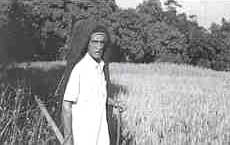Friends of Earth
 FOR Ganapathi Hedge, owner of a spice garden in Sirsee, Western India, each species is partner to the other. Human, animals and crops, all work together in creating a sustainable planet.
FOR Ganapathi Hedge, owner of a spice garden in Sirsee, Western India, each species is partner to the other. Human, animals and crops, all work together in creating a sustainable planet.
He says, "When you plant many different crops together, you get fruits and food throughout the year. Coconut takes 10 years to bear fruit. When we plant pepper, we know at best we'll get the pods in three years. Each crop is a sahayak, a partner to the other. A vine or a cardamom creeper keeps the spice garden cool for other plants, that's whey we plant it here and there... Plants support each other like husband and wife. Each plant gives help, and in return, receives help."
Meera Dewan's latest video film Sahayak - Species in Partnership celebrates the role of traditional farming communities in conserving biodiversity. It is the farmer, who traditionally ensures the continuity of the species.
Housewife Kamla Hegde reminisces in the film, "Each tree you see, have been planted by my husband and me. When they were still growing, wild boars would trample on them at night. The fruits, the arecas, the coconut trees - we protected them all, and look - how tall they've grown!.. These plants need support too... I carefully entwined each pepper vine around a banana tree."
Then the camera zooms in on the medicine chest where 85-year old Paravathiamma is the custodian of the vast knowledge of herbal plants and their healing properties. For 64 years, she has cultivated over 120 herbs, and dispenses free treatment to the ailing. "How can we charge for nature's plants and for our ancestors' wisdom..? How can I take money from my patients - it is their faith that keeps our knowledge alive," she says.
The film closes with a ritual thanksgiving where each grower brings the healthiest seeds as offerings. In a moving sequence, they examine each other's seeds, sharing the bounty.
But the traditional farming community represented by the film seems almost a mini-Utopia. Although the film alludes in passing to the patents issue, the POST-GATT scenario and its attendant and disurbing controversies are sidelined. Thus, many questions surface. How representative are these farmers of rural India today? Are many of them turning away from hybrid seeds, like the two women interviewed in the film? Is it possible to have a choice, with government subsidies luring farmers away from traditional farming? How many indigenous varieties have been lost already? The voiceovers irritate; subtitles would surely have been better. Also, the constant use of Sanskrit shlokas overemphasises a Brahminical tradition; the viewer wonders whether these chants are part of the Hedge household rituals or merely a scripting device? Despite these inadequacies, the film can serve as an useful means for initiating discussions on biodiversity and life patents.
Related Content
- The nature of business: corporate influence over the Convention on Biological Diversity and the global biodiversity framework
- Fuelling the crisis in Mozambique
- Meat atlas 2021: facts and figures about the animals we eat
- Essential rights for community forest management
- Agroecology: innovating for sustainable food systems and agriculture
- Why bees matter: the importance of bees and other pollinators for food and agriculture
